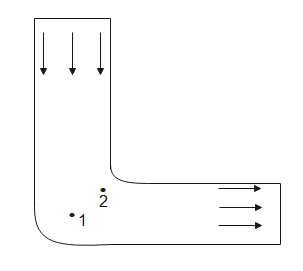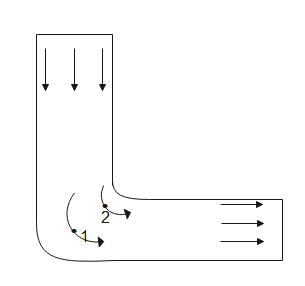
Ideal fluid flows along a flat tube of constant cross-section, located in a horizontal plane and bent as shown in the figure above (top view). The flow is steady. Are the velocities of the fluid equal at points 1 and 2?

A. Velocity at point 1 is less than the velocity at point 2.
B. Velocity at point 1 is more than the velocity at point 2.
C. Velocity at point 1 is equal to the velocity at point 2.
D. Can't be determined.

Answer
468k+ views
Hint: Bernoulli’s equation is the base for fluid mechanics and it is used to manufacture several machines. Machines like pump and diffuser are vastly used in the mechanical industry in order to extract the desired characteristics from the fluid flowing through them. By using Bernoulli’s theorem we can solve this
Formula used:
${P_1} + 0.5\rho {v_1}^2 = {P_2} + 0.5\rho {v_2}^2$
Complete step-by-step solution
It is clearly mentioned that the pipe is in a horizontal plane which means there is no effect of height variation in pressure change. As the fluid is flowing through the pipe its density doesn’t vary.
When an object is rotating in a circle its direction of velocity keeps on changing. When velocity changes there will be an acceleration and this contributes to the force. Now the force which is responsible for the change in direction in case of circular motion is called a centripetal force.
If we see the diagram below

The fluid elements between 1 and 2 are under circular motion. The centrifugal force experienced by the fluid elements is outwards i.e from 2 to 1. That means the pressure at 2 must be greater than the pressure at 1.
${P_2} > {P_1}$
We have Bernouli’s equation
${P_1} + 0.5\rho {v_1}^2 = {P_2} + 0.5\rho {v_2}^2$
From the above equation, since the pressure at 2 is greater than the pressure at 1, the velocity at 2 must be less than the velocity at 1 because velocity should decrease if pressure increases.
${v_1} > {v_2}$
Hence option B is correct.
Note: If we talk about Bernoulli’s law when the wind flows the paper on the calendar will fly up because the pressure under the page will be more and the pressure on the top will be less as the velocity of air on the top of the page is more and the velocity of air at the bottom of the page is less.
Formula used:
${P_1} + 0.5\rho {v_1}^2 = {P_2} + 0.5\rho {v_2}^2$
Complete step-by-step solution
It is clearly mentioned that the pipe is in a horizontal plane which means there is no effect of height variation in pressure change. As the fluid is flowing through the pipe its density doesn’t vary.
When an object is rotating in a circle its direction of velocity keeps on changing. When velocity changes there will be an acceleration and this contributes to the force. Now the force which is responsible for the change in direction in case of circular motion is called a centripetal force.
If we see the diagram below

The fluid elements between 1 and 2 are under circular motion. The centrifugal force experienced by the fluid elements is outwards i.e from 2 to 1. That means the pressure at 2 must be greater than the pressure at 1.
${P_2} > {P_1}$
We have Bernouli’s equation
${P_1} + 0.5\rho {v_1}^2 = {P_2} + 0.5\rho {v_2}^2$
From the above equation, since the pressure at 2 is greater than the pressure at 1, the velocity at 2 must be less than the velocity at 1 because velocity should decrease if pressure increases.
${v_1} > {v_2}$
Hence option B is correct.
Note: If we talk about Bernoulli’s law when the wind flows the paper on the calendar will fly up because the pressure under the page will be more and the pressure on the top will be less as the velocity of air on the top of the page is more and the velocity of air at the bottom of the page is less.
Recently Updated Pages
Master Class 9 General Knowledge: Engaging Questions & Answers for Success

Master Class 9 English: Engaging Questions & Answers for Success

Master Class 9 Science: Engaging Questions & Answers for Success

Master Class 9 Social Science: Engaging Questions & Answers for Success

Master Class 9 Maths: Engaging Questions & Answers for Success

Class 9 Question and Answer - Your Ultimate Solutions Guide

Trending doubts
What are the elders in Goa nostalgic about class 11 social science CBSE

Define least count of vernier callipers How do you class 11 physics CBSE

Write the differences between monocot plants and dicot class 11 biology CBSE

Which of the following is not a feature of the election class 11 social science CBSE

The mass of oxalic acid crystals H2C2O42H2O required class 11 chemistry CBSE

How many squares are there in a chess board A 1296 class 11 maths CBSE




